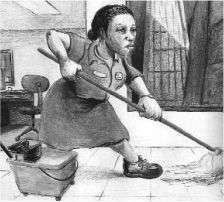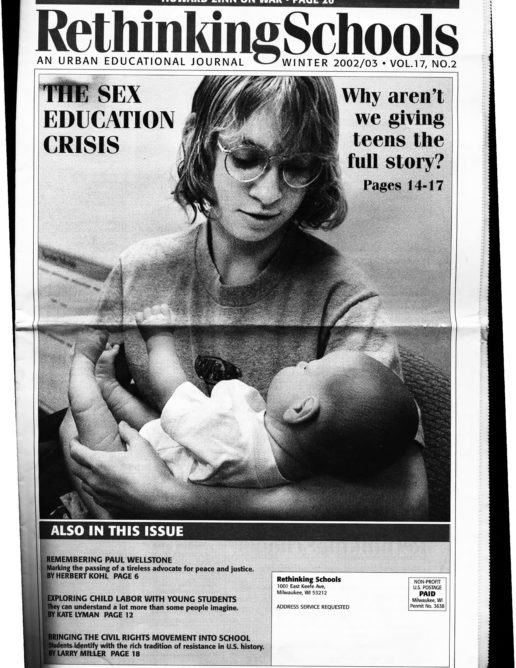Reading & Writing the World
Justice for janitors: Making the invisible visible
Illustrator: Francisco Delgado

Beneath steel and concrete, Beneath night’s wandering shadow,
Come the eyes, voices and arms – elbows and knees –
That make buildings shine, magnifying the sun into all our faces.
The nameless, the scorned, the ignored – yet
They are the humanity who make human things work.
– Luis Rodríguez
¡Sí, Se Puede! Yes, We Can!
¡Sí, Se Puede! Yes, We Can! Janitor Strike in L.A., written by Diana Cohn and illustrated by Francisco Delgado, (Cinco Puntos Press, 2002) is a celebration of the Justice for Janitors campaign in Los Angeles. In this bilingual picture book, Carlito’s mother goes on strike with 8,000 janitors who, in April 2000, put down their mops and brooms and demanded a living wage and respect for the work they perform. And they won! My favorite part of the story happens when an office worker from the building joins the striking janitors. He tells Carlito’s mother he’d never thought about the janitors who clean his office, “But seeing you in the bright light of day means I can never ignore you again.”
MAKING INJUSTICE VISIBLE
Part of our work as teachers is to make what is invisible — or taken for granted or ignored — visible for our students. Sometimes this means excavating historical injustices, sometimes it means looking at literature or history to find whose voices are marginalized or silenced. And sometimes it means asking students to look for those stories in their own lives.
Although the book’s intended audience is elementary students, ¡Sí, Se Puede! Yes, We Can! can be used as a model across grade levels. Teachers might use the book as an opening for a variety of lessons — on unions, strikes, solidarity, or local cuts in education budgets. In a recent workshop, I used it to raise the question of who is invisible in our lives.
As the high school language arts coordinator in Portland Public Schools, I miss my daily work with students, for the contact with hilarious, outrageous teenagers, but also as a laboratory for my teaching ideas. However, in my new job, I use the same prompts I developed for students as model lessons for teachers in my district.
I read aloud ¡Sí, Se Puede! Yes, We Can! to our Portland Writing Project meeting. After reading the book and discussing it, I come back to the man who said he’d never thought about the janitors who clean his office. Making those invisible hands visible means seeing the people behind the labor as Cohn does in this picture book. Then I give the writing assignment: Describe a time when you were invisible — or part of what poet Luis Rodríguez calls the “nameless, the scorned, the ignored.” What were the circumstances? Where did the incident(s) take place? What were you doing? Who else was there? How did you react? How did the situation make you feel? Or, tell the story of a time when someone who was invisible to you became visible. Who was the person? Where did the story take place? Who else was there? What happened to make the person transform for you? How did you feel about the experience?
Before we begin writing, I share some of my own experiences and ask participants to create their own list: the time when my P.E. teacher doted on my friend Janet, but couldn’t remember my name; at dances, when I stood alone waiting to be asked to dance — actually then I wished I were invisible and instead felt like I had a neon sign flashing “loser” across my forehead. When I worked as a waitress and became accustomed to being the hands and arms that served food. I became visible only when the customers realized they needed something and I wasn’t there. I tell about the experience of going out with my friend Nicole, an African-American woman. Waiters, store clerks, taxi drivers always spoke to me as if Nicole was not present. I also share how my student Tri, an immigrant from Vietnam, melted into the background for me. He was quiet. He slid into class and did his work. He never asked questions, nor did he ask for help. As I read his stories and poetry — which he rarely shared in class — it was like watching a black-and-white movie take on color. With every paper, with every conversation those papers generated, he took on more color, more life. He no longer disappeared.
Teachers at the workshop also shared their stories: Lori Flowers shared stories of attending events as the only African-American teacher and either being searched out as the center of attention or being invisible. Tracy Groom wrote about feeling invisible as both a student teacher and a substitute teacher. Ann Truax wrote about being nameless and faceless in high school. Franki Dennison’s piece reminded us about the invisibility of children by sharing the times she went to the store where she was ignored until an adult called attention to her.
Heidi Tolentino, who is biracial Japanese American and European American, wrote about an incident at a wedding where a man talked about the “damn Japs” while she sat silently nearby:
At first it didn’t jolt me. I almost didn’t hear it, or maybe I just didn’t want to. But when I lifted my head and my dark eyes connected with the bride’s blue ones across the table, I knew. She searched my face, silently asking me what to do. She glanced toward her grandfather, clasping her hands together, then nervously back to me. “Grandpa,” she scolded quietly, the color in her cheeks rising. Don’t make a scene the day before her wedding. I waved my hand from side to side and shook my head. “Let it go,” I mouthed to her. “Let it go.”
She let it go and for a moment, I hated her for it. Her grandfather glanced around at the others at the table and angrily replied, “We had to hate them, they were our enemy and we had to kill them.” That was his excuse for saying, “Damn Japs” right at the dinner table? He’d fought “them” fifty years before and that was his excuse? Nice try.
I guess he didn’t really see me sitting there. Not the real me, the one with the damn blood running through my veins. He didn’t know that my grandfather had served right beside him, fighting the same “enemy,” separated only by a wall of hatred, mistrust, and blame. He didn’t hear me either, because I kept it all inside.
Heidi took ¡Sí, Se Puede! Yes, We Can! and her piece back to class and shared it with her students – pregnant teenagers in an alternative education program.
EXTENSIONS
In high school classrooms, I might use this book prior to watching Bread and Roses, a fictionalized account of the Justice for Janitors campaign in Los Angeles. (The video is rated R for cursing and brief nudity, so check it out prior to using it with your students.) I would also read two chapters from Barbara Ehrenreich’s nonfiction book Nickel and Dimed: On (Not) Getting By in America — “Scrubbing in Maine” and “Selling in Minnesota” — which are both hilarious and tragic and end with her attempts to organize the Wal-Mart workers in Minnesota.
If we want students to care about “the nameless, the scorned, the ignored,” if we want them to learn to act in solidarity with others, to learn about compassion and justice and the rights of workers, we must make room in our classrooms for all of us to become visible.

